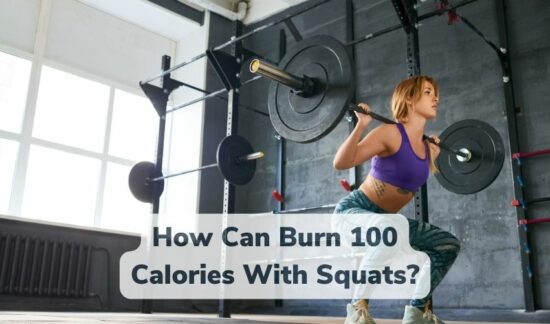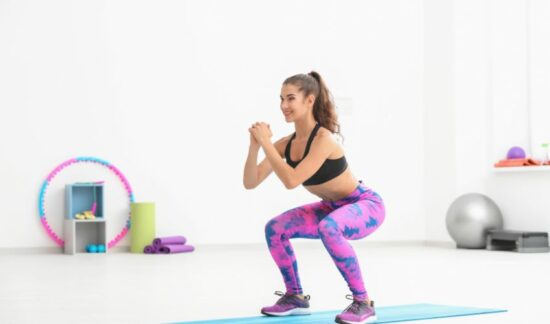Squats are a popular exercise that can help you tone and strengthen your lower body, but have you ever wondered how many squats it takes to burn 100 calories? In this post, we’ll explore the relationship between squats and calorie burn, and answer the question of how many squats you need to do to burn 100 calories.
Understanding how many squats are needed to burn 100 calories can be an important part of creating a successful weight loss or weight gain plan. Squats can be a valuable addition to a well-rounded exercise routine that includes a variety of exercises and focuses on overall health and fitness. By knowing how many squats it takes to burn 100 calories, you can better plan your workout routines and track your progress towards your fitness goals.
In this post, we’ll start by discussing the basics of calories and how they relate to weight loss/gain. We’ll then delve into the specifics of squats and their impact on burning calories, including an explanation of how the body burns calories during exercise. We’ll also cover the various factors that can affect calorie burn during exercise and the limitations of calculating calorie burn solely based on squats. Finally, we’ll provide an overview of other exercises that can burn 100 calories and compare the calorie-burning potential of squats to other exercises.
By the end of this post, you’ll have a better understanding of how many squats are needed to burn 100 calories, as well as the broader context of calorie burn and weight loss/gain. Let’s get started!

Understanding Calories and Squats
Calories are a unit of measurement that represents the energy content of food and the energy expenditure of the body. To maintain your weight, you need to balance the number of calories you consume through food and drink with the number of calories you burn through physical activity and bodily processes like breathing and digestion. If you consume more calories than you burn, you’ll gain weight, and if you burn more calories than you consume, you’ll lose weight.
Squats are a type of exercise that targets the lower body, including the glutes, quads, hamstrings, and calves. Squats can be performed with or without weights, and there are many variations, including basic bodyweight squats, jump squats, and sumo squats. Squats are considered a compound exercise, meaning they work multiple muscle groups at the same time and can burn a significant number of calories.
During exercise, the body burns calories to fuel the physical activity. The body primarily uses two energy sources during exercise: glycogen, which is stored in the muscles and liver, and fat, which is stored throughout the body. The body burns a combination of glycogen and fat during exercise, with the specific ratio depending on the intensity and duration of the exercise.
Squats can burn a significant number of calories because they engage large muscle groups and require a lot of energy to perform. The number of calories burned during squats depends on various factors, including the intensity and duration of the exercise, the weight of the individual, and their level of fitness. On average, a person can burn around 10-15 calories per minute doing squats, meaning it would take approximately 7-10 minutes of continuous squats to burn 100 calories.
In the next section, we’ll discuss the various factors that can affect calorie burn during exercise, which can help you better understand how many squats are needed to burn 100 calories.
Factors That Affect Calorie Burn.
Several factors can affect the number of calories burned during exercise, including:
- Body weight: Heavier individuals typically burn more calories during exercise than lighter individuals because it takes more energy to move their bodies.
- Exercise intensity: Higher intensity exercises like high-intensity interval training (HIIT) or weightlifting generally burn more calories per minute than lower intensity exercises like walking or yoga.
- Exercise duration: Longer exercise sessions generally burn more calories than shorter sessions, although the number of calories burned per minute may decrease as the body becomes fatigued.
- Muscle mass: Individuals with more muscle mass typically burn more calories during exercise because muscle tissue requires more energy to maintain than fat tissue.
- Resting metabolic rate: This is the number of calories your body burns at rest to maintain basic bodily functions. Individuals with higher resting metabolic rates typically burn more calories during exercise.
Understanding these factors can help you determine how many squats are needed to burn 100 calories. For example, a person who weighs more and performs higher intensity squats for a longer duration will burn more calories than someone who weighs less and performs lower intensity squats for a shorter duration.
In the next section, we’ll calculate how many squats are needed to burn 100 calories based on these factors.
How Many Squats to Burn 100 Calories?

The number of squats needed to burn 100 calories depends on several factors, including body weight, exercise intensity, and exercise duration.
As a general estimate, a person weighing around 150 pounds (68 kg) can burn approximately 100 calories by performing 100-120 squats at a moderate intensity level. This would take roughly 5-10 minutes, depending on the person’s speed and intensity.
However, keep in mind that the number of squats needed to burn 100 calories will vary based on each person’s individual factors such as weight, muscle mass, and metabolic rate. For instance, a person weighing more than 150 pounds will need to perform more squats to burn 100 calories, while a person weighing less than 150 pounds will need to perform fewer squats.
It’s also important to note that different types of squats can have different calorie-burning potentials. For example, a jump squat or a weighted squat will typically burn more calories per minute than a standard bodyweight squat.
However, it’s important to remember that calculating calorie burn solely based on squats has its limitations. While squats can be a great exercise for building strength and burning calories, they should be part of a well-rounded fitness routine that includes a mix of cardiovascular exercise, strength training, and flexibility training.
In the next section, we’ll explore other exercises that can be incorporated into a well-rounded fitness routine to burn 100 calories.
Other Exercises to Burn 100 Calories
There are many other exercises that can burn 100 calories in a relatively short amount of time. Here are a few examples:
- Jumping jacks: Performing jumping jacks at a moderate intensity level for 10-15 minutes can burn approximately 100 calories.
- Burpees: Burpees are a full-body exercise that can burn a significant amount of calories in a short amount of time. Performing burpees at a moderate intensity level for 7-10 minutes can burn approximately 100 calories.
- Running: Running is a great cardiovascular exercise that can burn a lot of calories in a short amount of time. Running at a moderate intensity level for 10-15 minutes can burn approximately 100 calories.
- Cycling: Cycling is another great cardiovascular exercise that can burn a lot of calories. Cycling at a moderate intensity level for 15-20 minutes can burn approximately 100 calories.
When comparing the calorie-burning potential of squats to other exercises, it’s important to keep in mind that the number of calories burned will depend on the individual’s weight, exercise intensity, and exercise duration.
However, as a general estimate, squats may burn fewer calories per minute than some of the other exercises listed above. For example, a person weighing around 150 pounds may need to perform 100-120 squats at a moderate intensity level to burn approximately 100 calories, which would take roughly 5-10 minutes. In comparison, running at a moderate intensity level for 10-15 minutes may burn approximately 100 calories.
It’s important to note that the best exercise to burn calories is the one that you enjoy and can maintain as part of a regular fitness routine. Incorporating a variety of exercises, including squats, can help create a well-rounded fitness routine and maximize calorie burn.
In the next section, we’ll wrap up the post with some final thoughts and a call to action.
Conclusion
In conclusion, knowing how many squats it takes to burn 100 calories can be a useful tool in achieving weight loss or maintenance goals. Squats are a versatile exercise that can be easily incorporated into a workout routine, and the number of calories burned can be affected by various factors such as intensity, form, and body composition.
While squats can be an effective way to burn calories, it is important to remember that they should be done in conjunction with a healthy diet and other types of exercise. Additionally, the number of calories burned during exercise is just one aspect of overall weight loss, and other factors such as diet and lifestyle choices also play a significant role.
By understanding the calorie-burning potential of squats and other exercises, individuals can make informed decisions about how to incorporate exercise into their weight loss or maintenance plan. So, go ahead and add squats to your workout routine, but don’t forget to listen to your body and consult a healthcare professional before starting any new exercise program.
We hope this post has been helpful in answering the question of how many squats it takes to burn 100 calories. Please share this post with your friends and family and let us know your feedback in the comments section below.
FAQs
When performing squats, how many calories do you manage to burn? When performed at a moderate level, one squat is equal to 0.32 calories; hence, performing normal intensity squats will cause you to burn approximately eight calories for every minute. Due to the fact that the typical number of squats completed in one minute is 25, performing 100 squats will result in the burning of 32 calories.